Abstract
AIM: To determine whether selenium supplementation of parenteral nutrition with 3 micrograms/kg/day of selenious acid is safe and effective in improving the selenium status of preterm infants. METHODS: Thirty eight preterm infants with mean (SEM) birthweight of 1171 (38) g and gestational age 29 (0.3) weeks were randomly allocated to a non-supplemented (PN-selenium, n = 19) or supplemented (PN+selenium, n = 19) group. The study began at 2.8 (0.2) (range 1-5) days of age. Term breastfed (n = 23) and formula fed (n = 8) infants were used as a reference group. RESULTS: Initially there was no difference between the preterm groups in plasma or erythrocyte selenium or glutathione peroxidase activity. Plasma selenium declined by a mean (SEM) of -13.3 (3.2) micrograms/l from 28 (4) to 16 (3) micrograms/l over the first three weeks in the PN-selenium group, but there was no fall in the supplemented infants and no net change in either group over six weeks. Over six weeks, there was a net decline in erythrocyte selenium of -106 (27) ng/g haemoglobin in the PN-selenium group, but no change in the PN+selenium group, such that at week 6 erythrocyte selenium was lower in the PN-selenium group (401 (17) ng/g haemoglobin) than the PN+selenium group (493 (25) ng/g haemoglobin). Urinary selenium was substantially higher in the PN+selenium group at each week. Initially term and preterm plasma selenium concentrations were similar, but they increased in term breastfed infants (+17 (2) micrograms/l), with both groups of preterm infants having lower plasma selenium concentrations at week 6 compared with term breastfed infants (PN-selenium 22 (3) micrograms/l; PN+selenium 23 (4) micrograms/l and term breastfed 49 (2) micrograms/l). CONCLUSIONS: Selenium supplementation of PN at 3 g/kg/day prevented depletion in newborns, but was inadequate to achieve selenium concentrations equivalent to those of breastfed term infants. Whether higher doses are more effective remains to be determined, particularly in light of the high urinary selenium secretion in supplemented infants. Selenium supplementation of both parenteral nutrition and formulas is recommended, but the optimal form and dose remain unclear.
Full text
PDF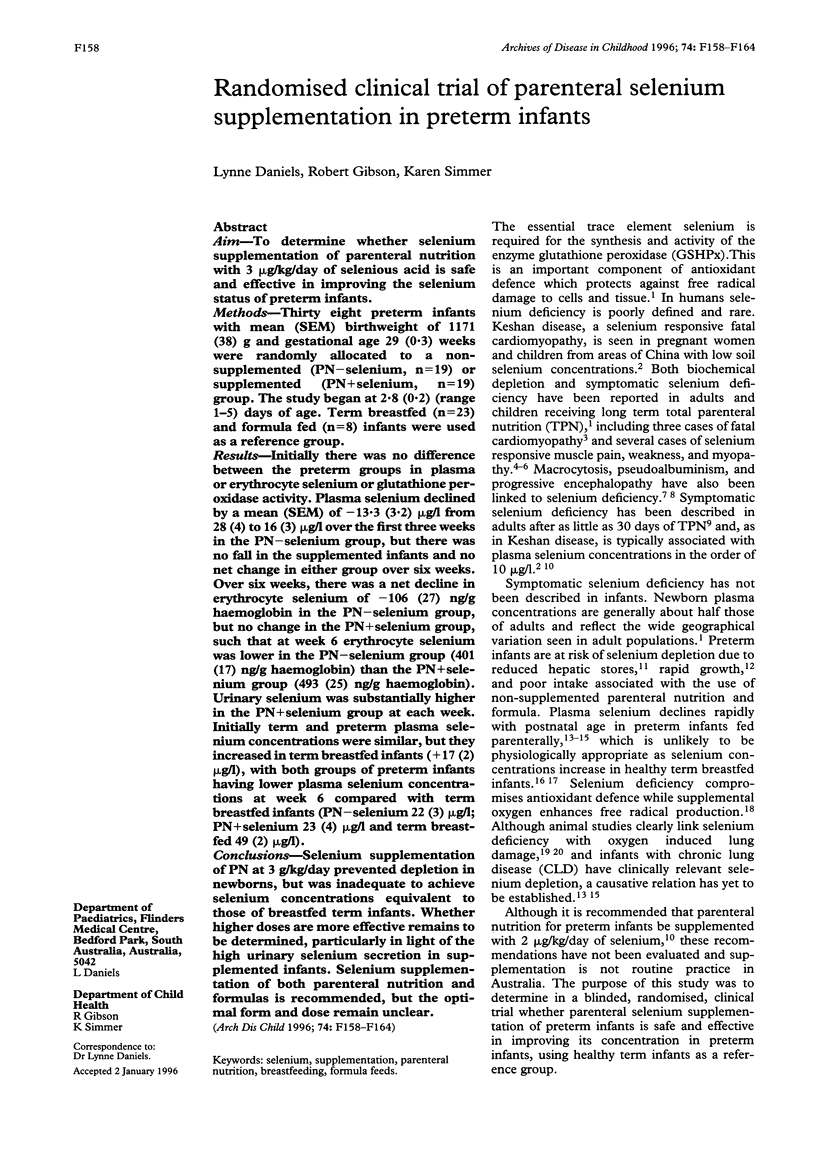
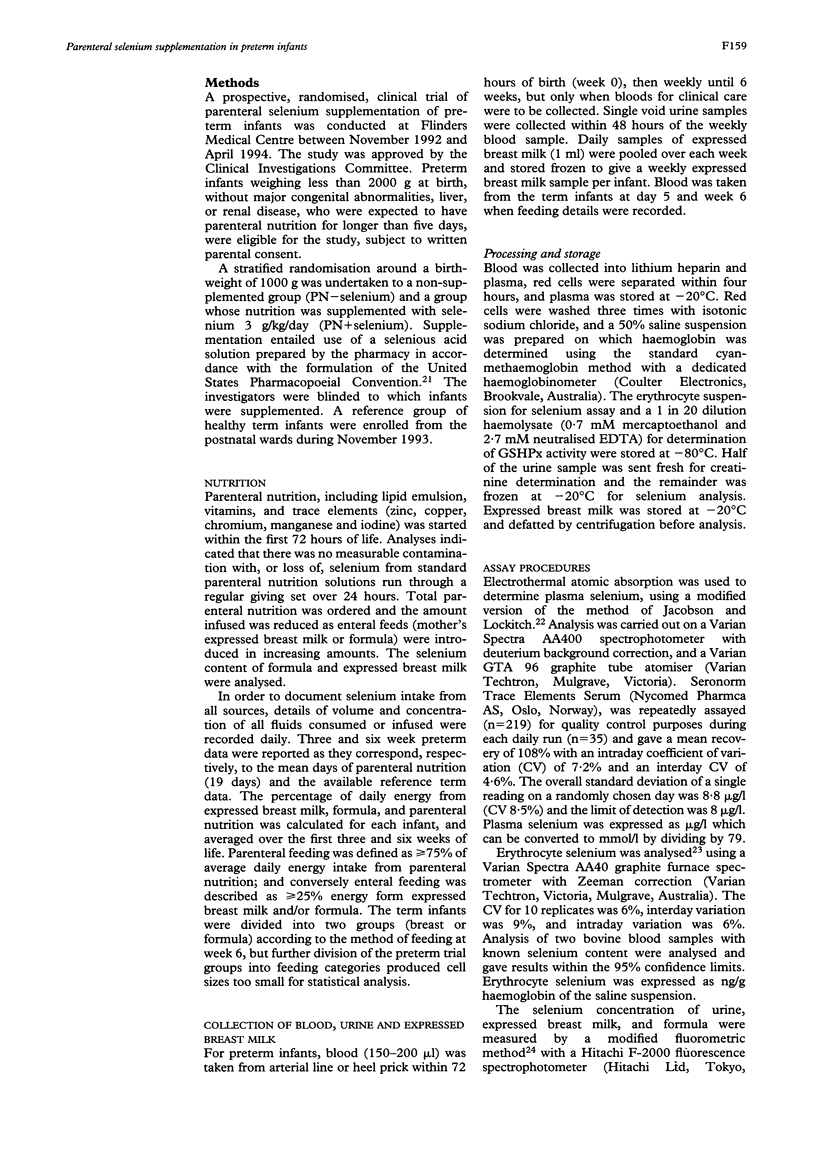
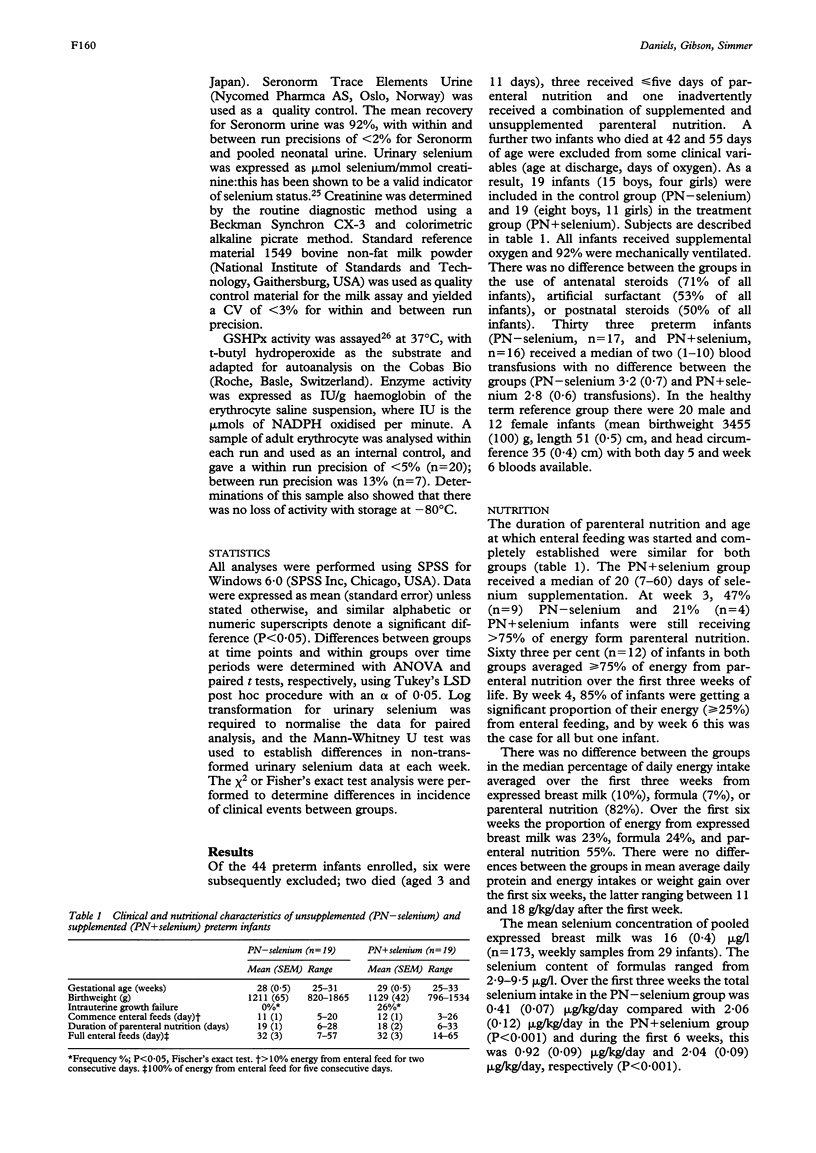
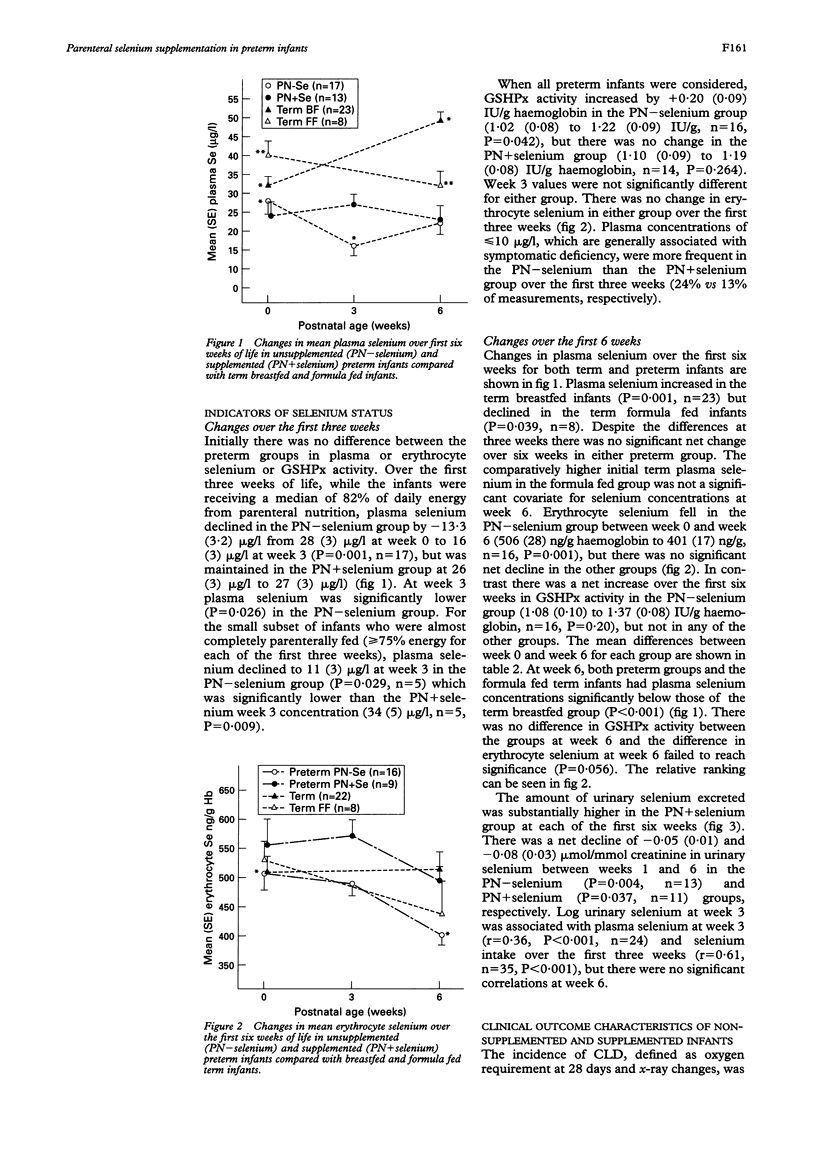
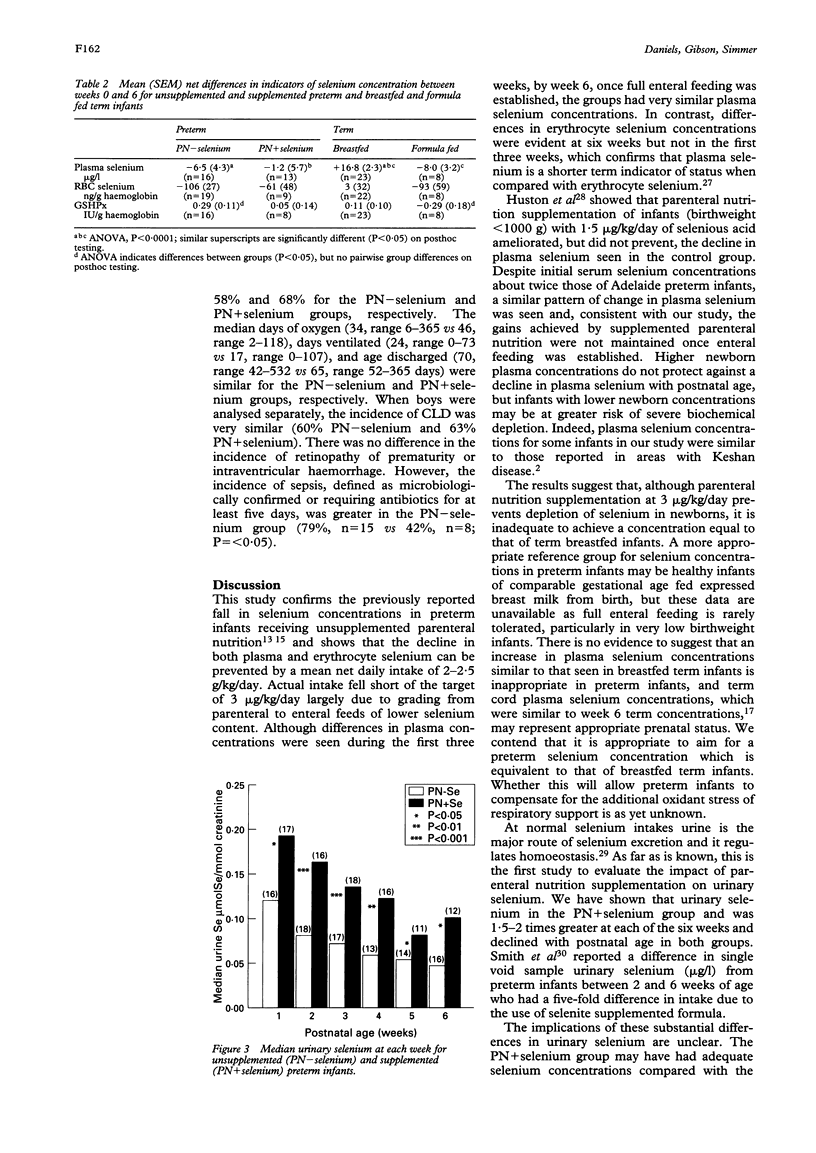
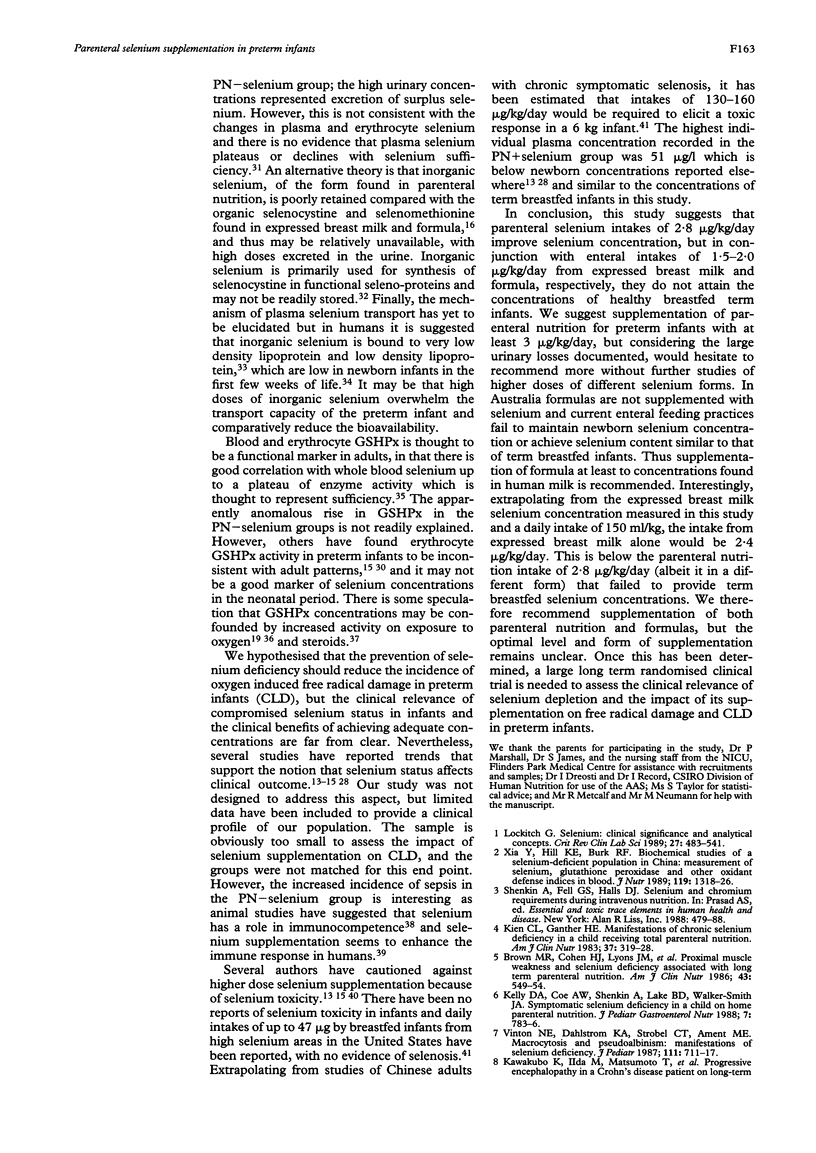
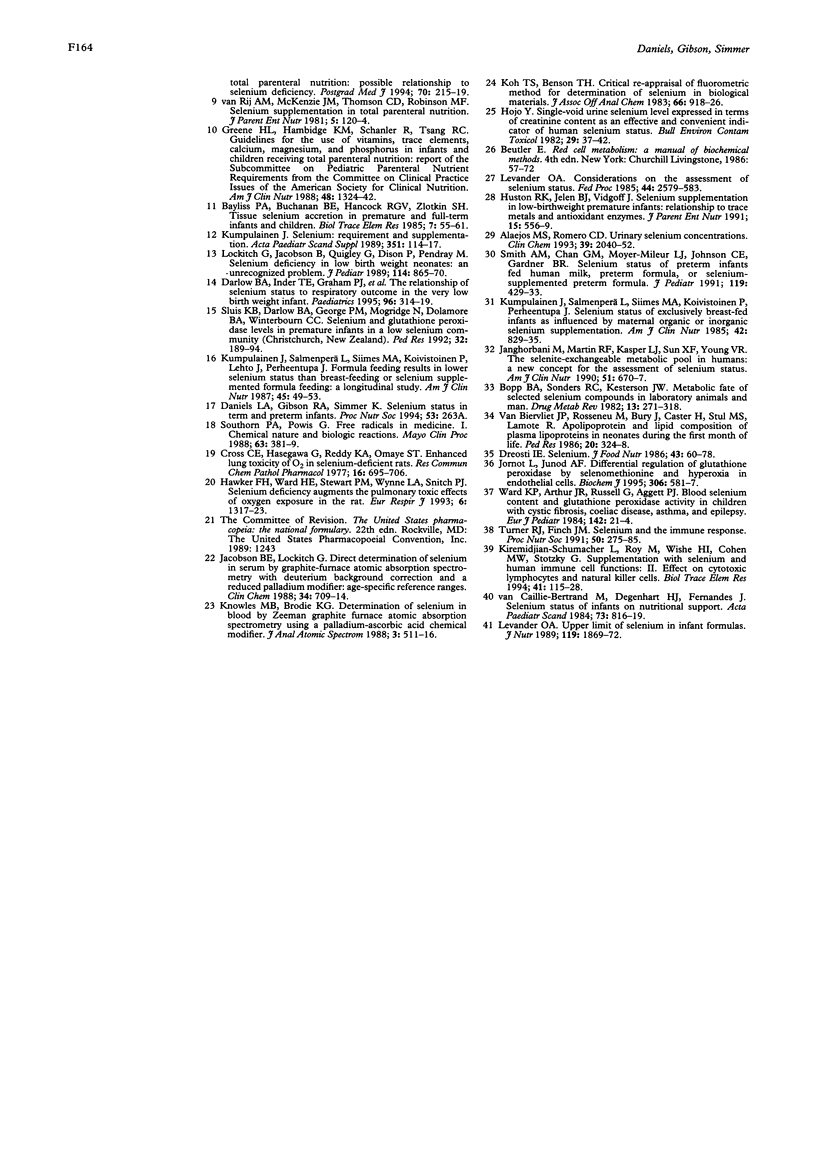
Selected References
These references are in PubMed. This may not be the complete list of references from this article.
- Bopp B. A., Sonders R. C., Kesterson J. W. Metabolic fate of selected selenium compounds in laboratory animals and man. Drug Metab Rev. 1982;13(2):271–318. doi: 10.3109/03602538209030000. [DOI] [PubMed] [Google Scholar]
- Brown M. R., Cohen H. J., Lyons J. M., Curtis T. W., Thunberg B., Cochran W. J., Klish W. J. Proximal muscle weakness and selenium deficiency associated with long term parenteral nutrition. Am J Clin Nutr. 1986 Apr;43(4):549–554. doi: 10.1093/ajcn/43.4.549. [DOI] [PubMed] [Google Scholar]
- Cross C. E., Hasegawa G., Reddy K. A., Omaye S. T. Enhanced lung toxicity of O2 in selenium-deficient rats. Res Commun Chem Pathol Pharmacol. 1977 Apr;16(4):695–706. [PubMed] [Google Scholar]
- Darlow B. A., Inder T. E., Graham P. J., Sluis K. B., Malpas T. J., Taylor B. J., Winterbourn C. C. The relationship of selenium status to respiratory outcome in the very low birth weight infant. Pediatrics. 1995 Aug;96(2 Pt 1):314–319. [PubMed] [Google Scholar]
- Greene H. L., Hambidge K. M., Schanler R., Tsang R. C. Guidelines for the use of vitamins, trace elements, calcium, magnesium, and phosphorus in infants and children receiving total parenteral nutrition: report of the Subcommittee on Pediatric Parenteral Nutrient Requirements from the Committee on Clinical Practice Issues of the American Society for Clinical Nutrition. Am J Clin Nutr. 1988 Nov;48(5):1324–1342. doi: 10.1093/ajcn/48.5.1324. [DOI] [PubMed] [Google Scholar]
- Hawker F. H., Ward H. E., Stewart P. M., Wynne L. A., Snitch P. J. Selenium deficiency augments the pulmonary toxic effects of oxygen exposure in the rat. Eur Respir J. 1993 Oct;6(9):1317–1323. [PubMed] [Google Scholar]
- Hojo Y. Single-void urine selenium level expressed in terms of creatinine content as an effective and convenient indicator of human selenium status. Bull Environ Contam Toxicol. 1982 Jul;29(1):37–42. doi: 10.1007/BF01606086. [DOI] [PubMed] [Google Scholar]
- Jacobson B. E., Lockitch G. Direct determination of selenium in serum by graphite-furnace atomic absorption spectrometry with deuterium background correction and a reduced palladium modifier: age-specific reference ranges. Clin Chem. 1988 Apr;34(4):709–714. [PubMed] [Google Scholar]
- Janghorbani M., Martin R. F., Kasper L. J., Sun X. F., Young V. R. The selenite-exchangeable metabolic pool in humans: a new concept for the assessment of selenium status. Am J Clin Nutr. 1990 Apr;51(4):670–677. doi: 10.1093/ajcn/51.4.670. [DOI] [PubMed] [Google Scholar]
- Jornot L., Junod A. F. Differential regulation of glutathione peroxidase by selenomethionine and hyperoxia in endothelial cells. Biochem J. 1995 Mar 1;306(Pt 2):581–587. doi: 10.1042/bj3060581. [DOI] [PMC free article] [PubMed] [Google Scholar]
- Kawakubo K., Iida M., Matsumoto T., Mochizuki Y., Doi K., Aoyagi K., Fujishima M. Progressive encephalopathy in a Crohn's disease patient on long-term total parenteral nutrition: possible relationship to selenium deficiency. Postgrad Med J. 1994 Mar;70(821):215–219. doi: 10.1136/pgmj.70.821.215. [DOI] [PMC free article] [PubMed] [Google Scholar]
- Kelly D. A., Coe A. W., Shenkin A., Lake B. D., Walker-Smith J. A. Symptomatic selenium deficiency in a child on home parenteral nutrition. J Pediatr Gastroenterol Nutr. 1988 Sep-Oct;7(5):783–786. doi: 10.1097/00005176-198809000-00029. [DOI] [PubMed] [Google Scholar]
- Kien C. L., Ganther H. E. Manifestations of chronic selenium deficiency in a child receiving total parenteral nutrition. Am J Clin Nutr. 1983 Feb;37(2):319–328. doi: 10.1093/ajcn/37.2.319. [DOI] [PubMed] [Google Scholar]
- Kiremidjian-Schumacher L., Roy M., Wishe H. I., Cohen M. W., Stotzky G. Supplementation with selenium and human immune cell functions. II. Effect on cytotoxic lymphocytes and natural killer cells. Biol Trace Elem Res. 1994 Apr-May;41(1-2):115–127. doi: 10.1007/BF02917222. [DOI] [PubMed] [Google Scholar]
- Koh T. S., Benson T. H. Critical re-appraisal of fluorometric method for determination of selenium in biological materials. J Assoc Off Anal Chem. 1983 Jul;66(4):918–926. [PubMed] [Google Scholar]
- Kumpulainen J., Salmenperä L., Siimes M. A., Koivistoinen P., Lehto J., Perheentupa J. Formula feeding results in lower selenium status than breast-feeding or selenium supplemented formula feeding: a longitudinal study. Am J Clin Nutr. 1987 Jan;45(1):49–53. doi: 10.1093/ajcn/45.1.49. [DOI] [PubMed] [Google Scholar]
- Kumpulainen J., Salmenperä L., Siimes M. A., Koivistoinen P., Perheentupa J. Selenium status of exclusively breast-fed infants as influenced by maternal organic or inorganic selenium supplementation. Am J Clin Nutr. 1985 Nov;42(5):829–835. doi: 10.1093/ajcn/42.5.829. [DOI] [PubMed] [Google Scholar]
- Kumpulainen J. Selenium: requirement and supplementation. Acta Paediatr Scand Suppl. 1989;351:114–117. doi: 10.1111/j.1651-2227.1989.tb11221.x. [DOI] [PubMed] [Google Scholar]
- Levander O. A. Considerations on the assessment of selenium status. Fed Proc. 1985 Jun;44(9):2579–2583. [PubMed] [Google Scholar]
- Levander O. A. Upper limit of selenium in infant formulas. J Nutr. 1989 Dec;119(12 Suppl):1869–1873. doi: 10.1093/jn/119.12_Suppl.1869. [DOI] [PubMed] [Google Scholar]
- Lockitch G., Jacobson B., Quigley G., Dison P., Pendray M. Selenium deficiency in low birth weight neonates: an unrecognized problem. J Pediatr. 1989 May;114(5):865–870. doi: 10.1016/s0022-3476(89)80154-4. [DOI] [PubMed] [Google Scholar]
- Lockitch G. Selenium: clinical significance and analytical concepts. Crit Rev Clin Lab Sci. 1989;27(6):483–541. doi: 10.3109/10408368909114596. [DOI] [PubMed] [Google Scholar]
- Sanz Alaejos M., Díaz Romero C. Urinary selenium concentrations. Clin Chem. 1993 Oct;39(10):2040–2052. [PubMed] [Google Scholar]
- Sluis K. B., Darlow B. A., George P. M., Mogridge N., Dolamore B. A., Winterbourn C. C. Selenium and glutathione peroxidase levels in premature infants in a low selenium community (Christchurch, New Zealand). Pediatr Res. 1992 Aug;32(2):189–194. doi: 10.1203/00006450-199208000-00013. [DOI] [PubMed] [Google Scholar]
- Smith A. M., Chan G. M., Moyer-Mileur L. J., Johnson C. E., Gardner B. R. Selenium status of preterm infants fed human milk, preterm formula, or selenium-supplemented preterm formula. J Pediatr. 1991 Sep;119(3):429–433. doi: 10.1016/s0022-3476(05)82058-x. [DOI] [PubMed] [Google Scholar]
- Southorn P. A., Powis G. Free radicals in medicine. I. Chemical nature and biologic reactions. Mayo Clin Proc. 1988 Apr;63(4):381–389. doi: 10.1016/s0025-6196(12)64861-7. [DOI] [PubMed] [Google Scholar]
- Turner R. J., Finch J. M. Selenium and the immune response. Proc Nutr Soc. 1991 Aug;50(2):275–285. doi: 10.1079/pns19910037. [DOI] [PubMed] [Google Scholar]
- Van Caillie-Bertrand M., Degenhart H. J., Fernandes J. Selenium status of infants on nutritional support. Acta Paediatr Scand. 1984 Nov;73(6):816–819. doi: 10.1111/j.1651-2227.1984.tb17781.x. [DOI] [PubMed] [Google Scholar]
- Vinton N. E., Dahlstrom K. A., Strobel C. T., Ament M. E. Macrocytosis and pseudoalbinism: manifestations of selenium deficiency. J Pediatr. 1987 Nov;111(5):711–717. doi: 10.1016/s0022-3476(87)80247-0. [DOI] [PubMed] [Google Scholar]
- Ward K. P., Arthur J. R., Russell G., Aggett P. J. Blood selenium content and glutathione peroxidase activity in children with cystic fibrosis, coeliac disease, asthma, and epilepsy. Eur J Pediatr. 1984 Apr;142(1):21–24. doi: 10.1007/BF00442584. [DOI] [PubMed] [Google Scholar]
- Webster A. J. Meat and right: the ethical dilemma. Proc Nutr Soc. 1994 Jul;53(2):263–270. doi: 10.1079/pns19940031. [DOI] [PubMed] [Google Scholar]
- Xia Y. M., Hill K. E., Burk R. F. Biochemical studies of a selenium-deficient population in China: measurement of selenium, glutathione peroxidase and other oxidant defense indices in blood. J Nutr. 1989 Sep;119(9):1318–1326. doi: 10.1093/jn/119.9.1318. [DOI] [PubMed] [Google Scholar]
- van Biervliet J. P., Rosseneu M., Bury J., Caster H., Stul M. S., Lamote R. Apolipoprotein and lipid composition of plasma lipoproteins in neonates during the first month of life. Pediatr Res. 1986 Apr;20(4):324–328. doi: 10.1203/00006450-198604000-00009. [DOI] [PubMed] [Google Scholar]


